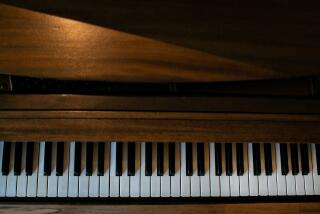Making the Most of What He Has Left
- Share via
NEW YORK — What does a pianist do after losing full use of his right hand and going to 18 doctors and getting 18 diagnoses?
Gary Graffman commissions works for the left hand.
Graffman has performed two world premieres of left-handed concertos this season: Daron Hagen’s “Seven Last Words” with the New Mexico Symphony and Richard Danielpour’s Piano Concerto No. 3 “Zodiac Variations” with the National Symphony in Washington, D.C. He will premiere a third, “Concierto para la mano izquierda” by Luis Prado, at Philadelphia’s Kimmel Center on Sunday.
In the 1950s, Graffman was among the so-called the OYAPs--Outstanding Young American Pianists--a group that included Van Cliburn, Leon Fleisher and Eugene Istomin and was to take over from the generation of Vladimir Horowitz, Arthur Rubinstein and Rudolf Serkin. At age 7, he started studying with Isabelle Vengerova of Philadelphia’s Curtis Institute of Music; at 20, he won the Leventritt Award; later, he studied with Horowitz and Serkin.
For 30 years, he performed 100 concerts a year.
Then in the late 1970s, he noticed his right ring finger and little finger would collapse when he reached for notes. There was nothing sudden and no pain, Graffman recalled during an interview in his stately apartment overlooking Carnegie Hall.
“It was little by little. I was having problems with certain [chord configurations], usually in Brahms. It was hard to realize that something was going wrong. It just seemed like, ‘Well, it’s a difficult [passage], and I’m getting older,’” said the 73-year-old pianist, who, despite the ailment, still shakes hands with a firm grip.
His wife, Naomi, said he was reluctant to have it looked at.
“‘They’ll think I’m crazy,’” she recalled his saying. “I said, ‘But you have to go to the doctor.’ I thought it was maybe some calcium spur. He said, ‘I don’t want to,’ but he finally did. And they did think he was crazy. And then came the great trek to the [18] different doctors [with the 18 diagnoses], which in retrospect is one of the most ridiculous experiences anybody could ever have.”
Graffman gave up performing and tried numerous remedies and pursued other interests. He studied Asian art history, learned some Mandarin and made many trips to Asia. The fruits of this passion fill his apartment, which has an impressive collection of Asian art (in addition to side-by-side Steinway grand pianos).
His medical problem eventually was determined to be a focal dystonia, in which the brain seems to get confused by the nerve impulses and sends out the wrong signals to an appendage.
“When he realized he wasn’t dying, he felt much better about it because they were all convinced he had some terminal illness,” Naomi Graffman said.
Still, there is no cure, and no treatment has worked for him.
During his performing hiatus, Graffman started to teach at Curtis and at the Manhattan School of Music and wrote the memoir “I Really Should Be Practicing.” He became director of Curtis in 1986 and has been its president since 1995.
He also started to learn the left-handed repertoire, as did his friend and colleague Fleisher, who also suffered from a right-hand problem but has recovered and can play from the two-handed repertoire.
The most famous piece for left-handed piano is a concerto by Maurice Ravel commissioned by Viennese pianist Paul Wittgenstein. A pianist’s right hand is more susceptible to injury because it generally plays the melody and is used more. Wittgenstein lost his right hand while fighting on the Russian front during World War I.
Wittgenstein also commissioned similar works by Sergei Prokofiev and Benjamin Britten. Erich Wolfgang Korngold, better known for his Hollywood scores, also wrote a concerto for him.
There are hundreds of other works for left hand, including a transcription of Bach’s solo violin “Chaconne” by Johannes Brahms for Clara Schumann, prepared after she strained her right hand. However, Graffman said he found the repertoire confining.
In recent years, Ned Rorem composed a piece for him. In 1996, William Bolcom composed a concerto for Graffman and Fleisher, “Gaea,” in which Graffman performed the first movement, Fleisher the second and both played the third.
Next season, Graffman is scheduled to perform with the Minnesota Orchestra a left-handed concerto written for him by Stanislaw Skrowaczewski.
The piece being premiered with the Chamber Orchestra of Philadelphia Sunday gives Graffman more than the opportunity to display his single-handed dexterity. Prado, the composer, graduated from Curtis. The conductor is Ignat Solzhenitsyn, the son of the Nobel Prize-winning author Alexander Solzhenitsyn and a former piano student of Graffman’s.
“As I’m getting older, more and more conductors that I play with, I signed their diplomas,” Graffman said.
More to Read
The biggest entertainment stories
Get our big stories about Hollywood, film, television, music, arts, culture and more right in your inbox as soon as they publish.
You may occasionally receive promotional content from the Los Angeles Times.










